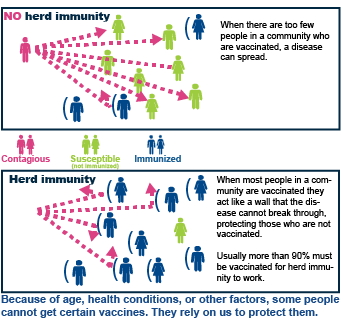So what exactly is community immunity?
Community immunity is when enough of the community has immunity to a contagious disease so community members who can’t be vaccinated are protected from infection. If you reduce the number of people who can get the disease, you limit the opportunity for the disease to spread.

Did you know...
The two ways to get herd immunity are when most people in a community get sick or get vaccinated.
Getting vaccinated is always safer.
For most diseases, the percent of the population that needs to have immunity from a disease in order to protect others is pretty high. For mumps, at least 3 out of 4 of us need to have immunity and for pertussis, it’s more like 9 out of 10. Either way, community immunity can only work if most of us are protected.
So exactly how many of us need to be vaccinated for community immunity?
The short answer is a lot!
- Mumps 75-85%
- Polio 80-86%
- Smallpox 80-85%
- Diphtheria 85%
- Rubella 83-85%
- Pertussis 92-95%
- Measles 83-94%
So why bother?
Well, even though most of the community needs to have immunity for community immunity to work, it DOES work. It protects those that cannot be immunized…and those are the people for whom a disease could be most serious.

© Voices for Vaccines. Excerpts and links may be used by websites and blogs, provided that full and clear credit is given to Voices for Vaccines, with appropriate and specific direction and links to the original content. Parents, providers, advocates, and others may download and duplicate toolkits in print, without alteration, for non-commercial use and with full and proper attribution only.
